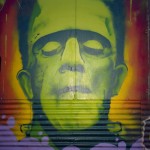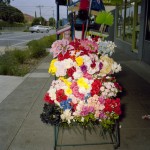THE POETRY OF JUNK
Sloggett. Even the name has strange phonetic reverences that call to mind associations of the discarded and the refused. Perhaps it’s the roots – slog and get – a process of slow, careful gleaning that throw me into a tangential reverie in front of the works by Melbourne’s photo-poet of the unloved.
Before you think that I have slipped and fell into a psychobubble, let me assure you that the formal rigour and conceptual consistency of Glen Sloggett’s exploration of his urban environment is devoid of the kind of cheap, hard-hitting sentimentality that plagues so much of so-called autobiographical mode of contemporary photography.
Yet, the photographs in his latest show are indeed deeply personal, emotionally felt experiences of the energies contained in material objects and banal everyday situations. If Sloggett’s previous series such as ‘Cheaper and Deeper’, contained a more pronounced critique of alienation inherent in the suburban culture, the works shown as part of the ‘A white trash (lost) love story’ series at the Stills Gallery, Sydney in February are devoid of such sharp, merciless outlook.
The style and format of the photographs is the same as in Sloggett’s earlier works: the images are large (80x80cm), square, printed with an abandunt white border, compositions luck obvious artistry, recalling snapshots, yet exhibit overwhelming detail. Colour is vibrant, almost kitschy in this case hinting at the hidden melodramatic subtext behind much of the imagery. People are conspicuous by their absence. Thus, for the photographer, every element found on the streets becomes a kind of a still-life: an almost dead memento for an event that is about to pass into obscurity. As the artist himself stated ‘no matter where I go, I always find places and environments that are in the process of falling down…I want to capture the last signs of optimism before inevitable disrepair.’
What is touching about these recent works is the evidence of the lone presence of the artist, made obvious by the intrusive camera flash. The startling harshness of the flash, forcefully singles out ubiquitous elements like a graffiti on a wall or a discarded piece of cardboard, from their everyday context. It is almost as if the photographer wants to exhume the loneliness contained in these unloved things and let the audience find a reflection of their own trashy love story. As such, the series becomes almost cathartic. Indeed, by concentrating on things discarded and refused by society, Sloggett asks us to pause and contemplate on the passage of time, mortality but also the extremely touching pleas for communication and connection (like the scrawl in wet concrete which says ‘U R ALONE’) that we tend to overlook in the rush flow of our daily lives.
The strength of Sloggett’s images lies in the photographer’s ability to retain the presence of these objects and environments, while simultaneously transforming them into metaphors.
Sloggett, who won the prestigious John and Margaret Baker fellowship for an emerging artist in 2001, has been widely exhibited in Australia as well being included in surveys of Australian photography overseas. He is also represented in major museum collections such as the Art Gallery of New South Wales. Despite this relative prominence on the art scene, the photographer continues to work in a factory manufacturing plastic vacuum moldings on the outskirts of suburban Melbourne, remaining vitally connected to the environment that feeds his art.
Glenn Sloggett’s one man show ‘A white trash love story’ was held at the Stills Gallery, Sydney, between February 1-25, 2012.
VG
- Glenn Sloggett. 2009. Amputee Op-Shop bride
- Glenn Sloggett. 2011. Frankenstein
- Glenn Sloggett. 2011. Life sux
- Glenn Sloggett. 2011. Plastic flowers
- Glenn Sloggett. 2011. You are alone









